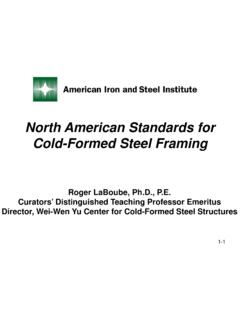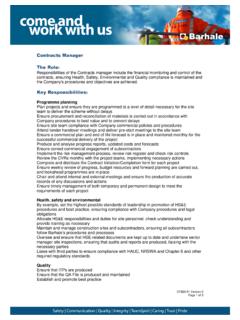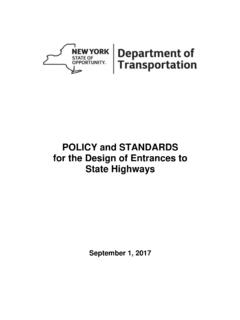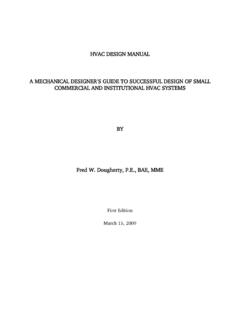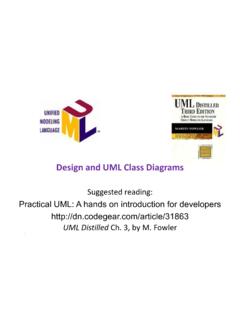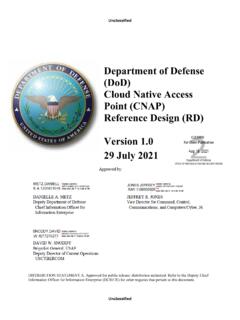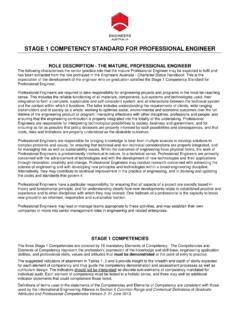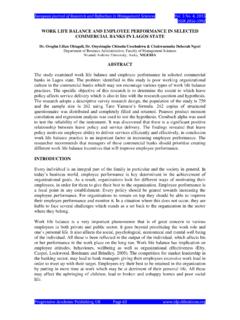Transcription of Design Responsibilities for Commercial Construction ...
1 Prepared with assistance from the Inland Empire Truss Fabricators Association, a local chapter of SBCA. View all SBCA Tech Notes at SBCA 6300 Enterprise Lane Madison, WI 53719 608/274-4849 608/274-3329 (fax) T-ID_IBCDResp09 Design Responsibilities for Commercial Construction Projects in the State of Idaho Released March 5, 2009 Background: SBCA has developed this Tech Note to clearly outline a component manufacturer s role and responsibility for Commercial Construction in the context of the building code and professional engineering law applicable in the State of Idaho. This Tech Note is based on the current engineering laws of the state Idaho1 and the 2006 Idaho Building Code, which is based on the nationally recognized model building code, the 2006 International Building Code (IBC)2. Issue: For projects involving Commercial Construction there is usually a registered Design professional (RDP) involved.
2 Confusion often occurs if the RDP, the owner, or the contractor assumes that the truss designer/truss manufacturer performs, at the very least, a portion of the role the RDP normally supplies. In contrast, the structural building component industry operates under the expectation that the RDP is the building designer and is therefore responsible for all of those items reserved for the building designer by the building code and applicable engineering law. Since there is so much misunderstanding in the market with regard to Design Responsibilities , this Tech Note is written to help alleviate the confusion. Summary of Recommendations and Conclusion: The Design of building stability bracing, connections of the truss components to the building, and the flow of loads through the building are generally required to be designed by a RDP. This RDP is usually the building designer, unless he has contractually delegated these Responsibilities to another party. The building code, referenced standard ANSI/TPI 1 and Idaho engineering law all provide guidance on where these Responsibilities fall.
3 Building Designer For residential Construction projects in the State of Idaho, the building designer is the RDP who has responsibility for the overall building Design in accordance with the state s statutes and regulations. Where the jurisdiction in which the project is constructed does not require a RDP, the building designer is the building owner, builder, or contractor. Truss Designer The building designer ( , owner or contractor) typically delegates the Design of all the individual trusses to the truss designer. The truss designer s responsibility is to properly Design the trusses according to the information provided in the Building Designer s Construction documents. The truss designer does not typically Design building stability bracing, connections of the truss components to the building, or the flow of loads through the building since these are outside of the scope of his responsibility and are reserved for the building designer. 1 For the latest professional engineering law see the following website: 2 IDAPA , adopts by reference the 2006 International Building Code, as published by the International Code Council, Inc.
4 SBCA Tech Notes Page 2 T-ID_IBCDResp09 Truss Manufacturer The truss manufacturer s primary responsibility is to manufacture the trusses in conformance with TPI 1. Many truss manufacturers also contract with an approved third party inspection agency to perform unannounced, periodic audits of the manufacturing facility to facilitate compliance with the building code framing inspection requirements. Contractor The contractor is responsible for the Construction means, methods, techniques, sequences, procedures, programs and safety in the context of implementing the Building Designer s Construction documents. With respect to the structural building components used, the contractor is responsible for the handling, storing, installation and bracing as defined in TPI 1, BCSI Guide to Good Practice for Handling, Installing, Restraining and Bracing of Metal Plate Connected Wood Trusses, or by the building designer. The contractor is the Construction professional that is most intimately familiar with the plans and specifications and how all the materials of Construction must fit together to transfer all loads through the entire building to the foundation.
5 This expertise is critical to overall building performance success. Building Official The building official is the person who examines the Construction documents for compliance with the IRC and is responsible for ensuring any necessary inspections are made. Upon successful inspection, the building official shall either approve that portion of the Construction as completed, or shall notify the permit holder (or his or her agent) wherein the same fails to comply with this code. When the foregoing Responsibilities are diligently followed, the Construction means, methods, techniques, sequences, procedures, programs and safety in implementing the Construction documents should proceed smoothly. This will ensure that the expectation is well met of how the plans and specifications, and all the materials of Construction , fit together to transfer all the loads through the entire building to the foundation. Analysis with Recommendations: The Structural Building Component industry, including those involved in the Design and manufacture of metal plate connected wood trusses, operates under the expectation that the Building Designer and the Contractor are professionals who are competent of undertaking the work they have agreed to perform on any given Commercial project, in compliance with all the legal requirements of engineering law, the building code, and the contracts that are entered into.
6 As such, the Design of building stability bracing, connections of the truss components to the building and the flow of loads through the building are, among other things, the responsibility of the building designer. The truss designer is responsible for the Design of the individual truss components and those items delegated to the truss designer as described in ANSI/TPI 1. In order to understand this issue, we must refer to the building code, referenced standard ANSI/TPI 1 and engineering law for guidance. A discussion of the Responsibilities of each of the entities involved in the Design process as stated in these documents follows. Building Designer For Commercial Construction projects in the State of Idaho, the building designer as used in this Tech Note is the Registered Design Professional (RDP) who has responsibility for the overall building Design in accordance with the state s statutes and regulations governing the professional registration and certification of architects and engineers.
7 According to section (see Appendix C for complete text) of the 2006 IBC, the Construction documents shall be prepared as follows: 2006 IBC Submittal documents.. The Construction documents shall be prepared by a registered Design professional where required by the statutes of the jurisdiction in which the project is to be SBCA Tech Notes Page 3 T-ID_IBCDResp09 The Construction documents should clearly define the scope of the project: 2006 IBC Information on Construction documents. Construction documents shall be dimensioned and drawn upon suitable Construction documents shall be of sufficient clarity to indicate the location, nature and extent of the work The building designer, who under Idaho law for Commercial Construction projects is an RDP, is also the person who reviews and coordinates any Construction documents that are prepared by others to make sure they do not conflict with the scope of the project, the specifics of which are listed in IBC Section (see Appendix C).
8 2006 IBC General..The registered Design professional in responsible charge shall be responsible for reviewing and coordinating submittal documents prepared by others, including phased and deferred submittal items, for compatibility with the Design of the On typical Commercial Construction projects, plans for fire alarm systems, manufactured trusses and sprinkler systems may not be completed at the time that the Construction documents are submitted for approval. These become known as "deferred submittals," and the building designer is responsible for reviewing them for general conformance to the Design of the building. This process is defined in IBC Section (see Appendix C). 2006 IBC Deferred submittals..Documents for deferred submittal items shall be submitted to the registered Design professional in responsible charge who shall review them and forward them to the building official with a notation indicating that the deferred submittal documents have been reviewed and been found to be in general conformance to the Design of the Nowhere in the IBC or Idaho law does it state that the Design Responsibilities of the parties involved change for those products handled on a deferred submittal basis.
9 In preparing the Construction documents, the building designer needs to provide the truss designer with the information necessary to properly Design the trusses for the building. According to ANSI/TPI 1-2002 (TPI 1), Chapter 2 (see Appendix D for complete text), which is adopted by reference in the IBC sections , , and Chapter 35 (see Appendix C and E), the following information should be provided: ANSI/TPI 1-2002 Section The Building provide the following: All Structural Element and Truss orientations and locations; Information to fully determine all Truss profiles; All Structural Element and Truss bearing conditions; The location, direction, and magnitude of all dead and live loads applicable to each Structural Element and All Structural Element and Truss anchorage designs required to resist uplift, gravity, and lateral loads; Allowable vertical and horizontal deflection criteria and any specific Proper transfer of Design loads affecting the Structural Elements and Trusses.
10 Adequate connections between Trusses and between Structural not Truss to Truss girder Permanent bracing Design for the permanent bracing for all Structural Elements and The Building Designer shall be responsible for the adequacy of the Design of the Building Structural System [and]..shall evaluate the effect of the Trusses and the Structural Elements supplied, on the Building Structural System. The truss manufacturer and truss designer must rely on the building designer to take the information provided by the truss Design drawing (TDD), the Building Component Safety Information (BCSI) booklet, and the building designer s analysis of the flow of loads through the building to Design a permanent SBCA Tech Notes Page 4 T-ID_IBCDResp09 building stability bracing system that takes the resisted truss member buckling loads (if any), and direct these loads to the building s intended load path system as follows (see Appendix D for the full text): ANSI/TPI 1-2002 Section.
